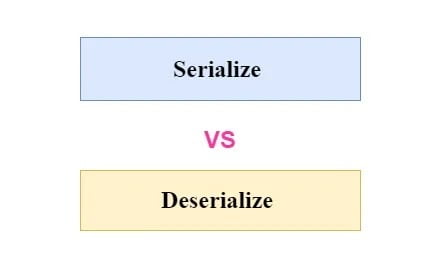In the intricate realm of computer science, the processes of serializing and deserializing a binary tree stand as pillars, supporting the efficient handling and manipulation of complex data structures. As we embark on this journey, we unravel the nuances of these operations, exploring their significance, differences, and practical implications in real-world applications.
Understanding the Essence of Serialization
The Power of Serialization
Binary tree serialization is the art of transforming a binary tree into a compact and portable format, often a string, allowing for easy storage, transmission, and reconstruction. Serialization is a pivotal concept, offering a bridge between in-memory data structures and their persistent or transferable counterparts.
The Core of Deserialization
On the flip side, binary tree deserialization is the process of reconstructing a binary tree from its serialized form. This is a fundamental operation when retrieving or transmitting data that has been serialized, as it breathes life back into the hierarchical structure of the tree.
Serializing a Binary Tree: A Deeper Dive
Pre-order Serialization
One prevailing technique in the realm of binary tree serialization is pre-order traversal. This method involves systematically traversing the tree in a specific order: first visiting the root, then the left subtree, and finally the right subtree. The serialized string is built incrementally, capturing the essence of the tree’s structure.
In-order Serialization
In contrast, in-order serialization follows a different approach. Here, the left subtree is visited first, followed by the root, and then the right subtree. This results in a serialized string that mirrors the sequence in which nodes would be encountered during an in-order traversal of the original tree.
Post-order Serialization
Post-order traversal for binary tree serialization traverses the left and right subtrees before finally visiting the root. The serialized string reflects this sequence, capturing the nodes in the order they would appear in a post-order traversal.
Deserializing a Binary Tree: The Art of Reconstruction
While serialization compresses a binary tree into a manageable format, deserialization is the key to resurrecting its intricate structure.
The Role of Recursion
Deserialization often employs recursive algorithms. Recursive descent into the serialized string involves extracting nodes and progressively reconstructing the tree. The process continues until the entire string is consumed, resulting in the complete restoration of the original binary tree.
Handling Null Nodes
Efficient deserialization must account for null nodes. These placeholders signify the absence of a left or right subtree for a particular node. Properly handling these null nodes during deserialization ensures accurate reconstruction of the binary tree.
Serialize vs Deserialize: Striking the Balance
In the binary tree universe, the interplay between serialization and deserialization is akin to a delicate dance. Striking the right balance is crucial for optimal performance and resource utilization.
Performance Considerations
Serialization tends to be a more straightforward process, as it involves capturing the tree’s structure in a linear fashion. On the other hand, deserialization, with its recursive nature, demands careful consideration of memory and processing overhead.
Use Cases Dictate Strategy
The decision to prioritize serialization over deserialization or vice versa often hinges on the specific use cases. In scenarios where data is frequently transmitted or stored, efficient serialization might take precedence. Conversely, applications heavily reliant on data retrieval may prioritize streamlined deserialization.
FAQs:
Q1. How does pre-order serialization differ from in-order serialization?
Answer: Pre-order serialization and in-order serialization differ in the sequence in which they traverse the binary tree. Pre-order starts with the root, followed by the left and right subtrees. In contrast, in-order serialization traverses the left subtree, then the root, and finally the right subtree. The resulting serialized strings capture distinct structures of the binary tree.
Q2. Can I prioritize either serialization or deserialization based on my application’s needs?
Answer: Yes, the priority between serialization and deserialization depends on the specific requirements of your application. If data transmission or storage efficiency is critical, prioritize serialization. On the other hand, if your application frequently retrieves and reconstructs data, streamlined deserialization might take precedence.
Q3. What challenges arise in handling null nodes during deserialization?
Answer: Handling null nodes during deserialization involves recognizing placeholders that signify the absence of left or right subtrees. The challenge lies in ensuring proper interpretation of these null nodes to accurately reconstruct the original binary tree structure.
Q4. Are there real-world applications where post-order serialization is more advantageous?
Answer: Post-order serialization is advantageous in scenarios where reconstructing the right subtree before the left is more efficient. This sequence can be beneficial in certain types of data processing or when dealing with specific hierarchical structures.
Q5. How does recursion play a vital role in the deserialization process?
Answer: Recursion is fundamental in deserialization as it enables the algorithm to descend through the serialized string, extracting nodes and progressively reconstructing the binary tree. The recursive approach simplifies the complex task of rebuilding the tree structure.
Q6. Can I use a combination of serialization techniques for different parts of a binary tree?
Answer: Yes, using a combination of serialization techniques for different parts of a binary tree is a viable strategy. Depending on the characteristics of specific subtrees, you can opt for pre-order, in-order, or post-order serialization to optimize the resulting serialized string.
Conclusion: Navigating the Binary Tree Landscape
In the intricate dance between serialization and deserialization of binary trees, developers must navigate a landscape of choices and considerations. Understanding the nuances of each operation is fundamental to crafting efficient algorithms that power a myriad of applications.

